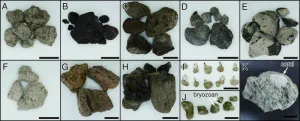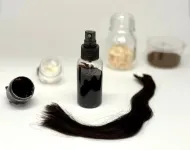(Press-News.org) NEW YORK, NY (Feb. 24, 2025)--A new study, led by researchers at Columbia University, suggests it is easy for youths to purchase cannabis from unlicensed dispensaries in New York City, despite state laws that bar access to recreational cannabis to those under age 21.
“Regulation to restrict access in this age group is based on evidence that cannabis affects working memory, brain development, and increases addiction risk when used at an early age,” says Ryan Sultán , an assistant professor of clinical psychiatry at Columbia University Vagelos College of Physicians and Surgeons who studies cannabis use and senior author of the study. “High-potency cannabis, which is much more prevalent today, has also been linked to adverse effects on physical and mental health in adolescents.”
New York State legalized recreational marijuana use in 2021 after establishing a medical marijuana program in 2014. The first licensed recreational cannabis outlets opened in late 2022. Licensed retailers are required to verify that customers are age 21 or over.
“Overnight, the city went from having a few medical marijuana dispensaries to having a bunch of dispensaries that may or may not have been licensed,” Sultán says. “But what happens when you deregulate cannabis without a plan to prevent kids from having easy access?”
Secret shopper finds easy access for kids
To find out, the researchers used Google Maps to create a directory of 840 cannabis outlets—including licensed medical marijuana dispensaries, licensed recreational marijuana dispensaries, unlicensed dispensaries, and smoke shops—across the five boroughs. Of these, 19 were licensed to sell cannabis products.
The team sent one of their research assistants, age 22, posing as an underage cannabis consumer, to visit a random selection of 37 stores in the directory to find out if age-verification, youth-oriented marketing strategies, and information about product quality differed by the type of retail outlet. The research assistant attempted to purchase cannabis at five licensed medical dispensaries, seven licensed recreational dispensaries, 10 unlicensed dispensaries, and 15 smoke shops (four of which denied selling cannabis products and were removed from the analysis).
The shopping trips revealed that unlicensed shops often engage in practices that can increase youth access to cannabis: They infrequently verified age, sold cheaper products, and used youth-friendly marketing practices.
All licensed dispensaries verified the customer’s age with a photo ID before permitting store entry, compared with 10% of unlicensed outlets.
“We also found that less than half of the unlicensed outlets verified age anywhere along the purchase journey, and most of these outlets also sold nicotine products, energy drinks, soda, and candy and used cartoon signage,” says Timothy Becker, a postdoctoral fellow in the Department of Psychiatry at Columbia and co-author of the study.
Licensed cannabis retailers were also more likely to adhere to a New York state regulation that requires them to post certificates of analysis describing the potency and quality of their cannabis products. Certificates of analysis were displayed more often at licensed dispensaries and at all licensed recreational dispensaries, though the potency of cannabis products were similar among all retail types.
“Though our findings may not be generalizable to other cities, they show that legalization of recreational cannabis creates a space for young people to purchase cannabis, creating the potential for harm as regulation struggles to keep up,” Sultán says.
More information
The article, “Cannabis Access by Retailer Type in New York City," was published online Feb. 24 in the journal Pediatrics.
Authors (all from Columbia):Timothy Becker, Mark Olfson, Peter Menzi, Frances Levin, Deborah Hasin, Collin Nuckolls, and Ryan Sultán.
###
Columbia University Irving Medical Center (CUIMC) is a clinical, research, and educational campus located in New York City. Founded in 1928, CUIMC was one of the first academic medical centers established in the United States of America. CUIMC is home to four professional colleges and schools that provide global leadership in scientific research, health and medical education, and patient care including the Vagelos College of Physicians and Surgeons, the Mailman School of Public Health, the College of Dental Medicine, the School of Nursing. For more information, please visit cuimc.columbia.edu.
END
Tokyo, Japan – Researchers from Tokyo Metropolitan University have carried out an unprecedentedly detailed survey of pumice rafts in the aftermath of the 2021 Fukutoku-Oka-no-Ba volcanic eruption in Japan. Using samples from 213 different locations, they considered raft density, the size and roundness of individual pumice, and biological species attached. Their findings revealed three phases in the evolution of drift pumice, involving rounding, fragmentation, and the diversification of attached biological organisms over time.
It is said that 85% of volcanic eruptions happen underwater. While their cousins on land might seem more vivid, the effects of underwater eruptions can be just as ...
Historically, access to geothermal energy has hinged on real estate’s famously three most important factors: location, location, and location. Because conventional geothermal power plants require hot, permeable rocks and plenty of underground fluid, use of the technology has been limited mostly to places with recent volcanism, such as Japan, New Zealand, the Philippines, Kenya, El Salvador, Iceland, and the western United States.
Over the past 50 years, however, techniques originally developed for oilfields and adapted for “enhanced geothermal systems” (EGS) have offered the promise ...
Many Medicare patients with advanced cancer receive potentially aggressive treatment at the expense of supportive care, according to a study that analyzed Medicare records.
The study, published in JAMA Health Forum, examined the quality of end-of-life care among 33,744 Medicare decedents. The study involved patients of diverse ethnic backgrounds, age 66 or older who died from breast, prostate, pancreatic or lung cancers.
Overall, claims records showed that 45% of the patients experienced potentially ...
As traditional candles burn, they can contribute to indoor air pollution by emitting volatile compounds and smoke, which may pose inhalation risks. Scented wax melts are often marketed as safer alternatives to candles because they’re flame- and smoke-free. But in a study in ACS’ Environmental Science & Technology Letters, researchers describe how aroma compounds released from the melted wax can react with ozone in indoor air to form potentially toxic particles.
Previous research has shown that scented wax melts emit more airborne scent compounds than traditional candles. The ...
ITHACA, N.Y. –Using underwater microphones and machine learning (ML), Cornell University researchers have developed a new method to estimate North Atlantic right whale numbers — offering a potentially safer and more cost-effective way to monitor this critically endangered species.
Their study, published in Endangered Species Research, demonstrates how microphones combined with ML and traditional aerial survey methods can help track right whale populations in Cape Cod Bay, a crucial feeding ground where the whales gather each spring.
To track this endangered species, researchers rely on costly and dangerous ...
For nearly two decades, scientists have tried to understand how negatively polarized platinum electrodes corrode, a costly mystery that plagues water electrolyzers, a promising energy technology for making hydrogen, as well as electrochemical sensors using platinum electrodes.
Now, a close collaboration between researchers at the Department of Energy’s SLAC National Accelerator Laboratory and the Leiden University has finally identified the culprit, potentially paving the way for cheaper hydrogen energy production and more reliable electrochemical sensors. The results were published in Nature Materials.
Electrolyzers ...
Agricultural fertilizers are critical for feeding the world’s population, restoring soil fertility and sustaining crops. Excessive and inefficient use of those resources can present an environmental threat, contaminating waterways and generating greenhouse gases such as nitrous oxide. Now, researchers reporting in ACS Agricultural Science & Technology have addressed those challenges with glass fertilizer beads. The beads control nutrient release, and the researchers say they’re environmentally compatible.
“The results show that glass fertilizers can be tailored to plant needs, slowly and sustainably releasing ...
Researchers at Stockholm University have developed a fully biobased hair conditioner using lignin gel emulsions, offering a sustainable and environmentally friendly alternative to conventional haircare products.
Hair conditioners typically contain 20–30 ingredients, many derived from petroleum and oleochemicals, raising concerns about sustainability and environmental impact. A new study published in Science Advances, demonstrates that micellar lignin gels can effectively stabilize emulsions with natural oils, reducing the need for synthetic surfactants and complex stabilizers commonly used in commercial formulations. The research team, led by Mika Sipponen at Stockholm University, ...
Perovskite solar cells are highly efficient and low cost in production. However, they still lack stability over the decades under real weather conditions. An international research collaboration led by Prof. Antonio Abate has now published a perspective on this topic in the journal Nature Reviews Materials. They explored the effects of multiple thermal cycles on microstructures and interactions between different layers of perovskite solar cells. They conclude that thermal stress is the decisive factor in the degradation of metal-halide perovskites. Based on this, they derive the most promising strategies to increase the long-term stability of perovskite solar cells.
Perovskites ...
University of Houston professors Birol Dindoruk, Megan Robertson and Francisco Robles Hernandez have joined the prestigious list of Senior Members of the National Academy of Inventors.
The University of Houston now has 39 faculty members in the NAI.
“We congratulate these three esteemed colleagues on being named NAI Senior Members,” said Ramanan Krishnamoorti, vice president for energy and innovation at UH. “This recognition is a testament to their dedication, research excellence and pursuit of real-world impact by knowledge and technologies. Their achievements continue to elevate the University as a leader in innovation and entrepreneurship.”
NAI Senior Members ...






